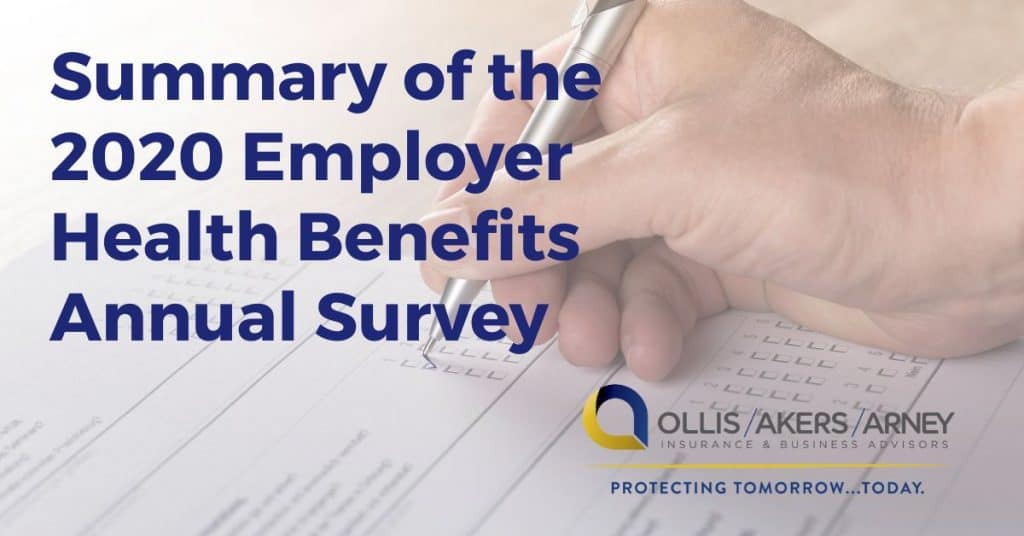Each year, the Kaiser Family Foundation conducts a survey to examine employer-sponsored health benefits trends. This document summarizes the main points of the 2020 survey and suggests how they could affect employers.
Health Insurance Premiums
In 2020, the average premium rose by 4% for both single coverage and family coverage. The average premiums were $7,470 and $21,342, respectively.
However, premiums for single coverage under high deductible health plans with a savings option (HDHP/SOs) were noticeably lower than the average single coverage premium. The family coverage average between HDHP/SOs and other plans was largely the same. HDHP/SOs’ annual premiums for single and family coverage were $6,890 and $20,359, respectively.
Worker Contributions
The average worker contribution toward the premium was 17% for single coverage and 27% for family coverage. Employees at organizations with a high percentage of lower-wage workers (where at least 35% make $25,000 or less annually) made above-average contributions toward family coverage—35% vs. 24% when compared to employees at firms with a smaller share of lower-wage workers.
In terms of dollar amounts, workers contributed $1,243 and $5,588 toward their premiums for single coverage and family coverage, respectively. Workers enrolled in HDHP/SOs contributed less on average, paying $1,061 for single coverage and $4,852 for family coverage.
Plan Enrollment
The following were the most common plan types in 2020:
- Preferred provider organizations (PPOs)—47% of workers covered
- HDHP/SOs—31% of workers covered
- Health maintenance organizations (HMOs)—13% of workers covered
- Point-of-service (POS) plans—8% of workers covered
HMO enrollment has gone up and down over the last several years (enrollment was up to 19% in 2019), so it’s unclear how this will trend in the near future.
Employee Cost Sharing
Most workers must pay a share of their health care costs, and the average deductible for all workers was $1,644 in 2020. The average annual deductible has increased by 25% over the past five years and nearly 80% over the past decade. The prevalence of HDHP/SOs has contributed to the increase of deductible amounts. The percentage of covered workers with a general deductible of $2,000 or greater has increased to 26% in the last five years.
Beyond deductibles, the vast majority of workers cover some portion of the costs from their health care services. For example, 65% of covered workers have coinsurance, and 13% have a copay for hospital admissions.
In addition, nearly all workers are covered by a plan with an out-of-pocket maximum (OOPM), but the costs vary considerably. Among covered workers with single coverage, 11% have an OOPM of less than $2,000, and 18% have an OOPM of $6,000 or more.
Availability of Employer-sponsored Coverage
Similar to the last few years, 56% of employers offer health benefits to at least some workers. Only 48% of very small employers (three to nine employees) offer coverage, while nearly every large employer (1,000 or more employees) offers coverage.
Health and Wellness Promotion Programs
Wellness programs help employees improve their lifestyles and avoid unhealthy habits. Fifty-three percent of small employers and 81% of large employers offer at least one wellness program in the areas of smoking cessation, weight management and lifestyle coaching. Of these large employers, 44% offer participation incentives like gift cards or merchandise.
Telemedicine
The large majority of employers with 50 or more workers have embraced telemedicine, with 85% offering health care services through this method. Within the last year, telemedicine offerings have increased significantly, especially among employers with between 50-199 workers.
Self-funding
Twenty-three percent of workers with small employers are enrolled in plans that are either partially or entirely self-funded, compared to 84% of workers with large employers. In the past few years, level-funded plans have become more popular. Level-funded plans are health plans provided by insurers that include a nominally self-funded option for small or mid-sized employers that incorporates stop-loss insurance with relatively low attachment points.
Conclusion
This year continues a period of a stable market, characterized by relatively low-cost growth for employer-sponsored coverage. While premium growth continues to exceed earnings and inflation increases, the differences are moderately small. Additionally, while there have been some changes in terms of employer-sponsored health benefits, no trends have gained significant traction.
However, it’s still unclear how the COVID-19 pandemic will affect employer health plans in 2021. Given the economic impact, employers may need to shift more costs to employees than they have in the past. Alternatively, employers may look to other funding models to provide competitive health benefits.
What’s more, 2020 is an election year, and a Supreme Court case regarding the Affordable Care Act is scheduled for around the same period. Both of these events could significantly impact employer health plans in unforeseen ways.
Looking forward, employers should begin to identify tools and resources they can use to offset higher premiums. As costs continue to rise and possible political changes ensue, employers and employees may begin to see increased market movement.
For more information on benefits offerings or on what you can do to control your health care costs, contact Ollis/Akers/Arney Insurance & Business Advisors today.
Ollis/Akers/Arney Benefits Team
John Akers – Vice President of Benefits
o: 417-334-5115 e: [email protected]
Ryan Allison – Advisor
o: 417-881-8333 e: [email protected]
Steve Baratta – Advisor
o: 417-881-8333 e: [email protected]
Cameron Black – Advisor / Director, Corporate Wellness Consulting
o: 417-881-8333 e: [email protected]
Erica Gaynor – Advisor / Account Executive
o: 417-881-8333 e: [email protected]
Hunter Thieme – Advisor
o: 417-881-8333 e: [email protected]
Pamela Hamilton – Benefits Supervisor
o: 417-881-8333 e: [email protected]
Heather Schudy – Associate Account Manager
o: 417-881-8333 e: [email protected]


